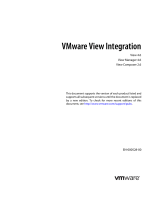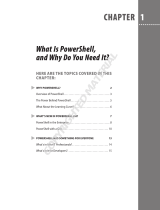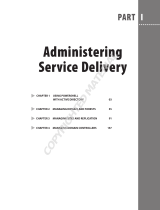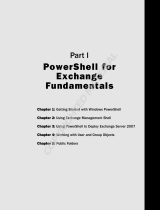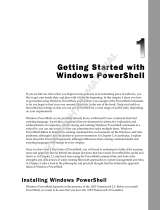Page is loading ...

VMware View Integration
View 5.0
View Manager 5.0
View Composer 2.7
This document supports the version of each product listed and
supports all subsequent versions until the document is replaced
by a new edition. To check for more recent editions of this
document, see http://www.vmware.com/support/pubs.
EN-000505-00

VMware, Inc.
3401 Hillview Ave.
Palo Alto, CA 94304
www.vmware.com
2 VMware, Inc.
VMware View Integration
You can find the most up-to-date technical documentation on the VMware Web site at:
http://www.vmware.com/support/
The VMware Web site also provides the latest product updates.
If you have comments about this documentation, submit your feedback to:
docfeedback@vmware.com
Copyright © 2011 VMware, Inc. All rights reserved. This product is protected by U.S. and international copyright and
intellectual property laws. VMware products are covered by one or more patents listed at
http://www.vmware.com/go/patents.
VMware is a registered trademark or trademark of VMware, Inc. in the United States and/or other jurisdictions. All other marks
and names mentioned herein may be trademarks of their respective companies.

VMware, Inc. 3
Contents
About This Book 5
1 Introduction 7
VMware View Components 7
Integration Interfaces to VMware View 8
2 Integrating with the Event Database 9
Event Database Tables and Schemas 9
Connection Broker Events 11
View Agent Events 17
View Administrator Events 17
View Transfer Server Events 25
Event Message Attributes 25
Sample Database Queries and Views 27
3 Using View PowerCLI 29
Introduction to View PowerCLI 29
Start the PowerShell Console with View PowerCLI Loaded 30
Displaying Help for a View PowerCLI cmdlet 30
Error Handling 30
Error When Piping and Specifying Objects at the Same Time 30
Escaping Characters in vCenter Path Names 31
View PowerCLI Cmdlets 31
View Administrator, View PowerCLI Cmdlet, and vdmadmin Operations 33
View PowerCLI Cmdlet Parameters 35
Default Display Protocol Settings 35
Deletion Policy Settings 35
Flash Quality Settings 36
Flash Throttling Settings 36
LDAP Backup Frequency 36
Pool Type Settings 37
Power Policy Settings 37
Refresh Policy Settings 38
Smart Card Authentication Settings 38
View Composer Maintenance Task Types 38
Examples of Using View PowerCLI Cmdlets 39
Displaying Information About a View Connection Server Instance 39
Updating the Configuration of a View Connection Server Instance 39
Managing the Configuration of vCenter Servers in VMware View 39
Managing Desktop Pools 39
Creating and Updating Automatically Provisioned Desktop Pools 40
Creating and Updating Linked-Clone Desktop Pools 40
Creating and Updating Manually Provisioned Desktop Pools 41
Creating Manual Unmanaged Desktop Pools 41
Creating and Updating Desktops Provisioned by Terminal Servers 41
Obtaining Information About Users and Groups from Active Directory 41
Managing Desktop Entitlements 42

VMware View Integration
4 VMware, Inc.
Managing Local Desktops 42
Managing Remote Sessions 42
Managing Virtual Machines 42
Displaying Information About Physical Computers 43
Updating the Ownership of Machines 43
Displaying Information About Events 43
Managing the Global Configuration of VMware View 43
Managing View Licenses 44
Examples of Using View PowerCLI for Enhanced Functionality 44
Checking if a View Connection Server Instance Is Running 44
Resize Automatic and Linked-Clone Desktop Pools 45
Determining Paths to vSphere Inventory Objects 46
Determining Paths to vSphere Datastore Objects 47
Adding and Removing Datastores 47
4 Customizing LDAP Data 49
LDAP Configuration Data 49
Export LDAP Configuration Data 50
Modify LDAP Configuration Data 50
Import LDAP Configuration Data 53
Import LDAP Configuration Data Using the LDIFDE Command 54
5 Integrating with SCOM 55
View Management Packs 55
Name a View Connection Server Group 56
Import the View MPs 56
View Discovery Script 56
Run the Discovery Script 57
Display Discovered Objects 57
Display Managed Objects 58
Views and Monitors 58
Performance Data Collection Settings 59
Enable a Proxy Agent on a Server 60
Display Performance Data 60
Display Information About an Alert 60
Restart a Service 60
Exclude a Domain from Connectivity Monitoring 60
Close Alerts 61
Class and Relationship Definitions 61
6 Examining PCoIP Session Statistics 65
Usage Notes for Recorded Statistics 65
General Session Statistics 66
Audio Statistics 66
Imaging Statistics 67
Network Statistics 67
USB Statistics 68
Examples of Using PowerShell to Examine PCoIP Statistics 68
Index 69

VMware, Inc. 5
This guide describes how to integrate VMware View™ software with third-party software such as
Windows PowerShell, business intelligence reporting engines, and Microsoft System Center Operations
Manager (SCOM).
Intended Audience
This book is intended for anyone who wants to customize or integrate software to work with View Manager.
The information in this manual is written for experienced Windows or Linux system administrators who are
familiar with virtual machine technology and datacenter operations.
VMware Technical Publications Glossary
VMware Technical Publications provides a glossary of terms that might be unfamiliar to you. For definitions
of terms as they are used in VMware technical documentation go to http://www.vmware.com/support/pubs.
Document Feedback
VMware welcomes your suggestions for improving our documentation. If you have comments, send your
feedback to docfeedback@vmware.com
Technical Support and Education Resources
The following sections describe the technical support resources available to you. To access the current version
of this book and other books, go to http://www.vmware.com/support/pubs.
Online and Telephone Support
To use online support to submit technical support requests, view your product and contract information, and
register your products, go to http://www.vmware.com/support.
Customers with appropriate support contracts should use telephone support for the fastest response on
priority 1 issues. Go to http://www.vmware.com/support/phone_support.
Support Offerings
To find out how VMware support offerings can help meet your business needs, go to
http://www.vmware.com/support/services.
About This Book

VMware View Integration
6 VMware, Inc.
VMware Professional Services
VMware Education Services courses offer extensive hands-on labs, case study examples, and course materials
designed to be used as on-the-job reference tools. Courses are available onsite, in the classroom, and live
online. For onsite pilot programs and implementation best practices, VMware Consulting Services provides
offerings to help you assess, plan, build, and manage your virtual environment. To access information about
education classes, certification programs, and consulting services, go to http://www.vmware.com/services.

VMware, Inc. 7
1
With VMware
View™, system administrators can provision desktops and control user access to these
desktops. Client software connects users to virtual desktops running on VMware vSphere™, or to physical
systems running within your network environment.
This chapter includes the following topics:
“VMware View Components” on page 7
“Integration Interfaces to VMware View” on page 8
VMware View Components
You can use VMware View with VMware vCenter Server to create desktops from virtual machines that are
running on VMware ESX
®
or VMware ESXi™ hosts and deploy these desktops to end users. In addition,
VMware View uses your existing Active Directory infrastructure for user authentication and management.
After you create a desktop, authorized end users can use Web-based or locally installed client software to
securely connect to centralized virtual desktops, back-end physical systems, or terminal servers.
VMware View consists of the following major components:
View Connection Server – a software service that acts as a broker for client connections by authenticating
and then directing incoming user requests to the appropriate virtual desktop, physical desktop, or
terminal server.
View Agent – a software service that is installed on all guest virtual machines, physical systems, or
terminal servers in order to allow them to be managed by VMware View. The agent provides features such
as connection monitoring, Virtual Printing, USB support, and single sign-on.
View Client – a software application that communicates with View Connection Server to allow users to
connect to their desktops.
View Client with Local Mode – a version of View Client that is extended to support the local desktop
feature, which allows users to download virtual machines and use them on their local systems.
View Administrator – a Web application that allows View administrators to configure View Connection
Server, deploy and manage desktops, control user authentication, initiate and examine system events, and
carry out analytical activities.
vCenter Server – a server that acts as a central administrator for ESX/ESXi hosts that are connected on a
network. A vCenter Server provides the central point for configuring, provisioning, and managing virtual
machines in the datacenter.
View Composer – a software service that is installed on a vCenter server to allow VMware View to rapidly
deploy multiple linked-clone desktops from a single centralized base image.
View Transfer Server – a software service that manages and streamlines data transfers between the
datacenter and View desktops that are checked out for use on end users' local systems. View Transfer
Server is required to support desktops that run View Client with Local Mode.
Introduction
1

VMware View Integration
8 VMware, Inc.
Integration Interfaces to VMware View
You can use several interfaces to integrate VMware View with external applications.
Event database – you can configure VMware View to record events to a Microsoft SQL Server or Oracle
database. You can then use business intelligence reporting engines to access and analyze this database.
View PowerCLI – you can use the PowerShell interface to perform a wide variety of administration tasks
on View components.
Lightweight Directory Access Protocol (LDAP) – you can export and import LDAP configuration data
from and into VMware View. You can create scripts that update this configuration data without accessing
View Administrator directly.
Microsoft System Center Operations Manager (SCOM) – you can monitor the operations of View
components from the SCOM console.
Windows Management Instrumentation (WMI) – you can examine performance statistics for a PCoIP
session.

VMware, Inc. 9
2
You can configure VMware View to record events to a Microsoft SQL Server or Oracle database. VMware View
records events such as the following examples:
End-user actions such as logging in and starting a desktop session.
Administrator actions such as adding entitlements and creating desktop pools.
Alerts that report system failures and errors.
Statistical sampling such as recording the maximum number of users over a 24-hour period.
You can use business intelligence reporting engines such as Crystal Reports, IBM Cognos, MicroStrategy 9,
and Oracle Enterprise Performance Management System to access and analyze the event database.
This chapter includes the following topics:
“Event Database Tables and Schemas” on page 9
“Connection Broker Events” on page 11
“View Agent Events” on page 17
“View Administrator Events” on page 17
“View Transfer Server Events” on page 25
“Event Message Attributes” on page 25
“Sample Database Queries and Views” on page 27
Event Database Tables and Schemas
Table 2-1 shows the tables that implement the event database in VMware View.
The event database prepends the names of these tables with a prefix that you define when you set up the
database. See the VMware View Installation document for more information.
Integrating with the Event Database
2
Table 2-1. Event Database Tables
Table Name Description
event Metadata and search optimization data for recent events.
event_data Data values for recent events.
event_data_historical Data values for all events.
event_historical Metadata and search optimization data for all events.
IMPORTANT VMware View does not restrict the growth of the event_historical and event_data_historical
tables. You must implement a space management policy for these tables.

VMware View Integration
10 VMware, Inc.
VMware View records details about events to all the database tables. After a certain period of time has elapsed
since writing an event record, VMware View deletes the record from the event and event_data tables. You can
use View Administrator to configure the time period for which the database keeps a record in the event and
event_data tables. See the VMware View Installation document for more information.
A unique primary key, EventID, identifies each event that VMware View records in the event and event_
historical tables. VMware View records data values for each event in the event_data and event_data_historical
tables. You can obtain the complete set of information for an event by joining the event and event_data tables
or the event_historical and event_data_historical tables on the EventID column.
The EventType, Severity, and Time columns in the event and event_historical tables identify the type and
severity of an event and the time at which it occurred.
Table 2-2 shows the schema for the event and event_historical tables.
N
OTE It is possible for events to be lost if you restart View Connection Server instances while the event
database is not running. For a solution that avoids this problem see http://kb.vmware.com/kb/1021461.
Table 2-2. Schema for the event and event_historical Tables
Column Name
Oracle
Data Type
SQLServer
Data Type Description
Acknowledged SMALLINT tinyint Whether VMware View acknowledged the
event.
0 = false
1 = true
DesktopId NVARCHAR2(512) nvarchar(512) Desktop ID of the associated pool.
EventID INTEGER int Unique primary key for the event.
EventType NVARCHAR2(512) nvarchar(512) Event name that corresponds to an item in
the message catalog. For example,
BROKER_USERLOGGEDIN.
FolderPath NVARCHAR2(512) nvarchar(512) Full path of the folder that contains the
associated object.
GroupId NVARCHAR2(512) nvarchar(512) SID of the associated group in Active
Directory.
LUNId NVARCHAR2(512) nvarchar(512) ID of the LUN that stores the associated
object.
MachineId NVARCHAR2(512) nvarchar(512) ID of the associated physical or virtual
machine.
Module NVARCHAR2(512) nvarchar(512) View component that raised the event. For
example, Admin, Broker, Tunnel,
Framework, Client, or Agent.
ModuleAndEventText NVARCHAR2(512) nvarchar(512) Event message with values substituted for
attribute parameters.
Node NVARCHAR2(512) nvarchar(512) Name of the virtual device node.
Severity NVARCHAR2(512) nvarchar(512) Severity level. For example, INFO,
WARNING, ERROR, AUDIT_SUCCESS,
AUDIT_FAIL.
Source NVARCHAR2(512) nvarchar(512) Identifier for the source of the event.
ThinAppId NVARCHAR2(512) nvarchar(512) ID of the associated ThinApp™ object.
Time TIMESTAMP datetime Time at which the event occurred,
measured from the epoch (January 1, 1970).
UserDiskPathId NVARCHAR2(512) nvarchar(512) ID of the user disk.
UserSID NVARCHAR2(512) nvarchar(512) SID of the associated user in Active
Directory.

VMware, Inc. 11
Chapter 2 Integrating with the Event Database
Table 2-3 shows the schema for the event_data and event_data_historical tables.
Connection Broker Events
Table 2-4 shows the event types for the connection broker.
The BROKER_DAILY_MAX_USERS event reports the maximum number of concurrent desktop sessions over
a 24-hour period. Short-lived sessions might not be included in the count because the sampling is performed
every five minutes.
The BROKER_VC_DISABLED and BROKER_VC_ENABLED events report the state of of the vCenter driver
that VMware View uses to track a vCenter Server. The BROKER_VC_STATUS_* events report the state of a
vCenter Server.
Table 2-3. Schema for the event_data and event_data_historical Tables
Column Name
Oracle
Data Type
SQLServer
Data Type Description
BooleanValue SMALLINT tinyint Value of a Boolean attribute.
0 = false
1 = true
EventID INTEGER int Unique primary key for the event.
IntValue INTEGER int Value of an integer attribute.
Name NVARCHAR2(512) nvarchar(512) Attribute name (for example,
UserDisplayName).
StrValue NVARCHAR2(512) nvarchar(512) Value of a string attribute. For other types
of attributes, this column contains an
interpretation of the data type as a string.
TimeValue TIMESTAMP datetime Value of a date and time attribute.
Type SMALLINT tinyint The data type of the attribute.
0 = StrValue
1 = IntValue
2 = TimeValue
3 = BooleanValue
Table 2-4. Connection Broker Events
EventType Severity ModuleAndEventText
BROKER_AGENT_OFFLINE WARNING The agent running on machine
${MachineName} has not responded to
queries, marking it as offline
BROKER_AGENT_ONLINE WARNING The agent running on machine
${MachineName} is responding again, but
did not send a startup message
BROKER_DAILY_MAX_USERS INFO ${Time}: Over the past 24 hours, the
maximum number of users with
concurrent desktop sessions was
${UserCount}
BROKER_DESKTOP_LAUNCH_FAILURE ERROR Unable to launch from Pool ${DesktopId}
for user ${UserDisplayName}: The broker
encountered an error while processing the
request, please contact support for
assistance
BROKER_DESKTOP_NOT_ENTITLED AUDIT_FAIL Unable to launch from Pool ${DesktopId}
for user ${UserDisplayName}: User is not
entitled to this Pool

VMware View Integration
12 VMware, Inc.
BROKER_DESKTOP_PROTOCOL_NOT_
SUPPORTED
AUDIT_FAIL Unable to launch from Pool ${DesktopId}
for user ${UserDisplayName}: Requested
protocol ${ProtocolId} is not supported
BROKER_DESKTOP_REQUEST INFO User ${UserDisplayName} requested Pool
${DesktopId}
BROKER_EVENT_HANDLING_STARTED INFO Broker ${BrokerName} has started
handling events
BROKER_EVENT_HANDLING_STOPPED INFO ${BrokerName} has stopped handling
events
BROKER_LOCALMODE_OLD_ANCHOR_
DELETE_FAILURE
WARNING Old anchor snapshot deletion task failed
for Machine ${MachineName}. Error
message: ${LocalModeMessage}
BROKER_LOCALMODE_OPERATION_AUDIT_
FAILURE
AUDIT_FAIL Local Mode Operation
${LocalModeOperation} failed for Desktop
${MachineName}, ID: ${DesktopId}. Error
message: ${LocalModeMessage}
BROKER_LOCALMODE_OPERATION_
FAILURE
ERROR Local Mode Operation
${LocalModeOperation} failed for Desktop
${MachineName}, ID: ${DesktopId}. Error
message: ${LocalModeMessage}
BROKER_LOCALMODE_OPERATION_
SUCCESS
AUDIT_SUCCESS ${LocalModeOperation} has completed for
Desktop ${MachineName}, ID:
${DesktopId}.
BROKER_MACHINE_ALLOCATED INFO User ${UserDisplayName} requested Pool
${DesktopId}, allocated machine
${MachineName}
BROKER_MACHINE_ASSIGNED_
UNAVAILABLE
AUDIT_FAIL Unable to launch from Pool ${DesktopId}
for user ${UserDisplayName}: Assigned
machine ${MachineName} is unavailable
BROKER_MACHINE_CANNOT_CONNECT AUDIT_FAIL Unable to launch from Pool ${DesktopId}
for user ${UserDisplayName}: Failed to
connect to Machine ${MachineName} using
${ProtocolId}
BROKER_MACHINE_CHECKEDOUT AUDIT_FAIL Unable to launch from Pool ${DesktopId}
for user ${UserDisplayName}: VM
${MachineName} is currently checked out
on a client device
BROKER_MACHINE_CONFIGURED_VIDEO_
SETTINGS
INFO Successfully configured video settings for
Machine VM ${MachineName} in Pool
${DesktopId}
BROKER_MACHINE_NOT_READY WARNING Unable to launch from Pool ${DesktopId}
for user ${UserDisplayName}: Machine
${MachineName} is not ready to accept
connections
BROKER_MACHINE_OPERATION_DELETED INFO machine ${MachineName} has been
deleted
BROKER_MACHINE_PROTOCOL_NOT_
SUPPORTED
AUDIT_FAIL Unable to launch from Pool ${DesktopId}
for user ${UserDisplayName}: Machine
${MachineName} does not support
protocol ${ProtocolId}
BROKER_MACHINE_PROTOCOL_
UNAVAILABLE
AUDIT_FAIL Unable to launch from Pool ${DesktopId}
for user ${UserDisplayName}: Machine
${MachineName} did not report protocol
${ProtocolId} as ready
Table 2-4. Connection Broker Events (Continued)
EventType Severity ModuleAndEventText

VMware, Inc. 13
Chapter 2 Integrating with the Event Database
BROKER_MACHINE_REJECTED_SESSION WARNING Unable to launch from Pool ${DesktopId}
for user ${UserDisplayName}: Machine
${MachineName} rejected the start session
request
BROKER_MACHINE_SESSION_TIMEDOUT WARNING Session for user ${UserDisplayName}
timed out
BROKER_POOL_CANNOT_ASSIGN AUDIT_FAIL Unable to launch from Pool ${DesktopId}
for user ${UserDisplayName}: There are no
machines available to assign the user to
BROKER_POOL_COMANAGER_REQUIRED AUDIT_FAIL Unable to launch from Pool ${DesktopId}
for user ${UserDisplayName}: No
co-management availability for protocol
${ProtocolId}
BROKER_POOL_EMPTY AUDIT_FAIL Unable to launch from Pool ${DesktopId}
for user ${UserDisplayName}: The Desktop
Pool is empty
BROKER_POOL_NO_MACHINE_ASSIGNED AUDIT_FAIL Unable to launch from Pool ${DesktopId}
for user ${UserDisplayName}: No machine
assigned to this user
BROKER_POOL_NO_RESPONSES AUDIT_FAIL Unable to launch from Pool ${DesktopId}
for user ${UserDisplayName}: No
machines in the Desktop Pool are
responsive
BROKER_POOL_OVERLOADED AUDIT_FAIL Unable to launch from Pool ${DesktopId}
for user ${UserDisplayName}: All
responding machines are currently in use
BROKER_POOL_POLICY_VIOLATION AUDIT_FAIL Unable to launch from Pool ${DesktopId}
for user ${UserDisplayName}: This
Desktop Pool does not allow online
sessions
BROKER_POOL_PROTOCOL_NOT_
SUPPORTED
AUDIT_FAIL Unable to launch from Pool ${DesktopId}
for user ${UserDisplayName}: There were
no machines available that support
protocol ${ProtocolId}
BROKER_POOL_PROTOCOL_UNAVAILABLE AUDIT_FAIL Unable to launch from Pool ${DesktopId}
for user ${UserDisplayName}: There were
no machines available that reported
protocol ${ProtocolId} as ready
BROKER_POOL_TUNNEL_NOT_SUPPORTED AUDIT_FAIL Unable to launch from Pool ${DesktopId}
for user ${UserDisplayName}: Tunnelling
is not supported for protocol ${ProtocolId}
BROKER_PROVISIONING_ERROR_CONFIG_
CLEARED
INFO The previously reported configuration
problem is no longer present on Pool
${DesktopId}
BROKER_PROVISIONING_ERROR_CONFIG_
SET
ERROR Provisioning error occurred on Pool
${DesktopId} because of a configuration
problem
BROKER_PROVISIONING_ERROR_DISK_
CLEARED
INFO The previously reported disk problem is no
longer present on Pool ${DesktopId}
BROKER_PROVISIONING_ERROR_DISK_LC_
RESERVATION_CLEARED
INFO The previously reported error due to
available free disk space reserved for linked
clones is no longer present on Pool
${DesktopId}
Table 2-4. Connection Broker Events (Continued)
EventType Severity ModuleAndEventText

VMware View Integration
14 VMware, Inc.
BROKER_PROVISIONING_ERROR_DISK_LC_
RESERVATION_SET
ERROR Provisioning error occurred on Pool
${DesktopId} because available free disk
space is reserved for linked clones
BROKER_PROVISIONING_ERROR_DISK_SET WARNING Provisioning error occurred on Pool
${DesktopId} because of a disk problem
BROKER_PROVISIONING_ERROR_LICENCE_
CLEARED
INFO The previously reported licencing problem
is no longer present on Pool ${DesktopId}
BROKER_PROVISIONING_ERROR_LICENCE_
SET
ERROR Provisioning error occurred on Pool
${DesktopId} because of a licencing
problem
BROKER_PROVISIONING_ERROR_
NETWORKING_CLEARED
INFO The previously reported networking
problems with a View Agent are no longer
present on Pool ${DesktopId}
BROKER_PROVISIONING_ERROR_
NETWORKING_SET
ERROR Provisioning error occurred on Pool
${DesktopId} because of a networking
problem with a View Agent
BROKER_PROVISIONING_ERROR_RESOURCE_
CLEARED
INFO The previously reported resource problem
is no longer present on Pool ${DesktopId}
BROKER_PROVISIONING_ERROR_RESOURCE_
SET
ERROR Provisioning error occurred on Pool
${DesktopId} because of a resource
problem
BROKER_PROVISIONING_ERROR_TIMEOUT_
CUSTOMIZATION_CLEARED
INFO The previously reported timeout while
customizing is no longer present on Pool
${DesktopId}
BROKER_PROVISIONING_ERROR_TIMEOUT_
CUSTOMIZATION_SET
ERROR Provisioning error occurred on Pool
${DesktopId} because of a timeout while
customizing
BROKER_PROVISIONING_ERROR_VM_
CLONING
ERROR Provisioning error occurred for Machine
${MachineName}: Cloning failed for
Machine
BROKER_PROVISIONING_ERROR_VM_
CUSTOMIZATION_ERROR
ERROR Provisioning error occurred for Machine
${MachineName}: Customization failed for
Machine
BROKER_PROVISIONING_ERROR_VM_
CUSTOMIZATION_NETWORKING
ERROR Provisioning error occurred for Machine
${MachineName}: Customization error due
to no network communication between the
View agent and Connection Server
BROKER_PROVISIONING_ERROR_VM_
CUSTOMIZATION_TIMEOUT
ERROR Provisioning error occurred for Machine
${MachineName}: Customization
operation timed out
BROKER_PROVISIONING_SVI_ERROR_
COMPOSER_AGENT_INIT_FAILED
ERROR Provisioning error occurred for Machine
${MachineName}: View Composer agent
initialization failed
BROKER_PROVISIONING_SVI_ERROR_
RECONFIG_FAILED
ERROR Provisioning error occurred for Machine
${MachineName}: Reconfigure operation
failed
BROKER_PROVISIONING_SVI_ERROR_REFIT_
FAILED
ERROR Provisioning error occurred for Machine
${MachineName}: Refit operation
${SVIOperation} failed
BROKER_PROVISIONING_SVI_ERROR_
REMOVING_VM
ERROR Provisioning error occurred for Machine
${MachineName}: Unable to remove
Machine from inventory
Table 2-4. Connection Broker Events (Continued)
EventType Severity ModuleAndEventText

VMware, Inc. 15
Chapter 2 Integrating with the Event Database
BROKER_PROVISIONING_VERIFICATION_
FAILED_USER_ASSIGNED
WARNING Provisioning verification failed for
Machine ${MachineName}: User is already
assigned to a machine in Pool ${DesktopId}
BROKER_PROVISIONING_VERIFICATION_
FAILED_USER_CANNOT_BE_ASSIGNED
WARNING Provisioning verification failed for
Machine ${MachineName}: A user cannot
be assigned because Pool ${DesktopId} is
not persistent
BROKER_PROVISIONING_VERIFICATION_
FAILED_VMNAME_IN_USE
WARNING Provisioning verification failed for
Machine ${MachineName}: A machine
already exists in Pool ${DesktopId} with
name ${MachineName}
BROKER_SECURITY_SERVER_ADD_FAILED AUDIT_FAIL Failed to add security server
${SecurityServerId}
BROKER_SECURITY_SERVER_ADD_FAILED_
PASSWORD_EXPIRED
AUDIT_FAIL Failed to add security server
${SecurityServerId}, pairing password
expired
BROKER_SECURITY_SERVER_ADD_FAILED_
PASSWORD_INCORRECT
AUDIT_FAIL Failed to add security server
${SecurityServerId}, pairing password
incorrect
BROKER_SECURITY_SERVER_ADD_FAILED_
PASSWORD_NOT_SET
AUDIT_FAIL Failed to add security server
${SecurityServerId}, pairing password not
set
BROKER_SECURITY_SERVER_ADDED AUDIT_SUCCESS Security server ${SecurityServerId} added
BROKER_SVI_ARCHIVE_UDD_FAILED AUDIT_FAIL Failed to archive user data disk
${UserDiskName} to location ${SVIPath}
BROKER_SVI_ARCHIVE_UDD_SUCCEEDED AUDIT_SUCCESS Archived user data disk ${UserDiskName}
to location ${SVIPath}
BROKER_SVI_ATTACH_UDD_FAILED AUDIT_FAIL Failed to attach user data disk
${UserDiskName} to VM ${SVIVMID}
BROKER_SVI_ATTACH_UDD_SUCCEEDED AUDIT_SUCCESS Attached user data disk ${UserDiskName}
to VM ${SVIVMID}
BROKER_SVI_DETACH_UDD_FAILED AUDIT_FAIL Failed to detach user data disk
${UserDiskName} from VM ${SVIVMID}
BROKER_SVI_DETACH_UDD_SUCCEEDED AUDIT_SUCCESS Detached user data disk ${UserDiskName}
from VM ${SVIVMID}
BROKER_USER_AUTHFAILED_ACCOUNT_
DISABLED
AUDIT_FAIL User ${UserDisplayName} failed to
authenticate because the account is
disabled
BROKER_USER_AUTHFAILED_ACCOUNT_
EXPIRED
AUDIT_FAIL User ${UserDisplayName} failed to
authenticate because the account has
expired
BROKER_USER_AUTHFAILED_ACCOUNT_
LOCKED_OUT
AUDIT_FAIL User ${UserDisplayName} failed to
authenticate because the account is locked
out
BROKER_USER_AUTHFAILED_ACCOUNT_
RESTRICTION
AUDIT_FAIL User ${UserDisplayName} failed to
authenticate because of an account
restriction
BROKER_USER_AUTHFAILED_BAD_USER_
PASSWORD
AUDIT_FAIL User ${UserDisplayName} failed to
authenticate because of a bad username or
password
BROKER_USER_AUTHFAILED_GENERAL AUDIT_FAIL User ${UserDisplayName} failed to
authenticate
Table 2-4. Connection Broker Events (Continued)
EventType Severity ModuleAndEventText

VMware View Integration
16 VMware, Inc.
BROKER_USER_AUTHFAILED_NO_LOGON_
SERVERS
AUDIT_FAIL User ${UserDisplayName} failed to
authenticate because there are no logon
servers
BROKER_USER_AUTHFAILED_PASSWORD_
EXPIRED
AUDIT_FAIL User ${UserDisplayName} failed to
authenticate because the password has
expired
BROKER_USER_AUTHFAILED_PASSWORD_
MUST_CHANGE
AUDIT_FAIL User ${UserDisplayName} failed to
authenticate because the password must
change
BROKER_USER_AUTHFAILED_SECUREID_
ACCESS_DENIED
AUDIT_FAIL SecurID access denied for user
${UserDisplayName}
BROKER_USER_AUTHFAILED_SECUREID_
NEWPIN_REJECTED
AUDIT_FAIL SecurID access denied for user
${UserDisplayName} because new pin was
rejected
BROKER_USER_AUTHFAILED_SECUREID_
WRONG_NEXTTOKEN
AUDIT_FAIL SecurID access denied for user
${UserDisplayName} because wrong next
token entered
BROKER_USER_AUTHFAILED_SECUREID_
WRONG_STATE
AUDIT_FAIL SecurID access denied for user
${UserDisplayName} because of incorrect
state
BROKER_USER_AUTHFAILED_TIME_
RESTRICTION
AUDIT_FAIL User ${UserDisplayName} failed to
authenticate because of a time restriction
BROKER_USER_NOT_AUTHORIZED AUDIT_FAIL User ${UserDisplayName} has
authenticated, but is not authorized to
perform the operation
BROKER_USER_NOT_ENTITLED AUDIT_FAIL User ${UserDisplayName} has
authenticated, but is not entitled to any
Pools
BROKER_USERCHANGEDPASSWORD AUDIT_SUCCESS Password for ${UserDisplayName} has
been changed by the user
BROKER_USERLOGGEDIN AUDIT_SUCCESS User ${UserDisplayName} has logged in
BROKER_USERLOGGEDOUT AUDIT_SUCCESS User ${UserDisplayName} has logged out
BROKER_VC_DISABLED INFO vCenter at address ${VCAddress} has been
temporarily disabled
BROKER_VC_ENABLED INFO vCenter at address ${VCAddress} has been
enabled
BROKER_VC_STATUS_CHANGED_CANNOT_
LOGIN
WARNING Cannot log in to vCenter at address
${VCAddress}
BROKER_VC_STATUS_CHANGED_DOWN INFO vCenter at address ${VCAddress} is down
BROKER_VC_STATUS_CHANGED_INVALID_
CREDENTIALS
WARNING vCenter at address ${VCAddress} has
invalid credientials
BROKER_VC_STATUS_CHANGED_NOT_YET_
CONNECTED
INFO Not yet connected to vCenter at address
${VCAddress}
BROKER_VC_STATUS_CHANGED_
RECONNECTING
INFO Reconnecting to vCenter at address
${VCAddress}
BROKER_VC_STATUS_CHANGED_UNKNOWN WARNING The status of vCenter at address
${VCAddress} is unknown
BROKER_VC_STATUS_CHANGED_UP INFO vCenter at address ${VCAddress} is up
MULTIPLE_DESKTOPS_FOR_KIOSK_USER WARNING User ${UserDisplayName} is entitled to
multiple desktop pools
Table 2-4. Connection Broker Events (Continued)
EventType Severity ModuleAndEventText

VMware, Inc. 17
Chapter 2 Integrating with the Event Database
View Agent Events
Table 2-5 shows the event types for View Agent.
View Administrator Events
Table 2-6 shows the event types for View Administrator.
Table 2-5. View Agent Events
EventType Severity ModuleAndEventText
AGENT_CONNECTED INFO User ${UserDisplayName} has logged in to a new session on
machine ${MachineName}
AGENT_DISCONNECTED INFO User ${UserDisplayName} has disconnected from machine
${MachineName}
AGENT_ENDED INFO User ${UserDisplayName} has logged off machine
${MachineName}
AGENT_PENDING INFO The agent running on machine ${MachineName} has accepted an
allocated session for user ${UserDisplayName}
AGENT_PENDING_
EXPIRED
WARNING The pending session on machine ${MachineName} for user
${UserDisplayName} has expired
AGENT_RECONFIGURED INFO Machine ${MachineName} has been successfully reconfigured
AGENT_RECONNECTED INFO User ${UserDisplayName} has reconnected to machine
${MachineName}
AGENT_RESUME INFO The agent on machine ${MachineName} sent a resume message
AGENT_SHUTDOWN INFO The agent running on machine ${MachineName} has shut down,
this machine will be unavailable
AGENT_STARTUP INFO The agent running on machine ${MachineName} has contacted the
connection server and sent a startup message
AGENT_SUSPEND INFO The agent on machine ${MachineName} sent a suspend message
Table 2-6. View Administrator Events
EventType Severity ModuleAndEventText
ADMIN_ADD_DESKTOP_ENTITLEMENT AUDIT_SUCCESS ${EntitlementDisplay} was entitled to Pool
${DesktopId} by ${UserDisplayName}
ADMIN_ADD_LICENSE AUDIT_SUCCESS ${UserDisplayName} added license
ADMIN_ADD_LICENSE_FAILED AUDIT_FAIL ${UserDisplayName} failed to add license
ADMIN_ADD_PM AUDIT_SUCCESS ${UserDisplayName} added physical
machine ${MachineName} to Pool
${DesktopId}
ADMIN_ADD_PM_FAILED AUDIT_FAIL ${UserDisplayName} failed to add physical
machine ${MachineName} to Pool
${DesktopId}
ADMIN_ADD_THINAPP_ENTITLEMENT AUDIT_SUCCESS Application ${ThinAppDisplayName} was
assigned to Desktop ${MachineName} by
${UserDisplayName}
ADMIN_ADD_THINAPP_ENTITLEMENT_
FAILED
AUDIT_FAIL ${UserDisplayName} failed to add
Application entitlement
ADMIN_ADD_THINAPP_POOL_
ENTITLEMENT
AUDIT_SUCCESS Application ${ThinAppDisplayName} was
assigned to Pool ${DesktopId} by
${UserDisplayName}
ADMIN_ADMINSTRATOR_REMOVE_FAILED AUDIT_FAIL ${UserDisplayName} failed to remove all
permissions for Administrator
${AdminPermissionEntity}

VMware View Integration
18 VMware, Inc.
ADMIN_ADMINSTRATOR_REMOVED AUDIT_SUCCESS ${UserDisplayName} removed all
permissions for Administrator
${AdminPermissionEntity}
ADMIN_CONFIGURE_TRANSFER_SERVER_
LOCAL_REPO
INFO Configure a local Transfer Server
Repository. Path ${PathName}
ADMIN_CONFIGURE_TRANSFER_SERVER_
NETWORK_REPO
INFO Configure a network Transfer Server
Repository. Path: ${PathName}, domain:
${DomainName}, user name
${DomainUser}
ADMIN_CONNECTION_BROKER_UPDATE_
FAILED
AUDIT_FAIL ${UserDisplayName} failed to update
connection broker ${BrokerId}
ADMIN_CONNECTION_BROKER_UPDATED AUDIT_SUCCESS ${UserDisplayName} updated connection
broker ${BrokerId}: (${AttrChangeType}:
${AttrName} = ${AttrValue})
ADMIN_CONNECTION_SERVER_BACKUP_
FAILED
AUDIT_FAIL ${UserDisplayName} failed to initiate a
backup of connection broker ${BrokerId}
ADMIN_CONNECTION_SERVER_BACKUP_
INITIATED
AUDIT_SUCCESS ${UserDisplayName} initiated a backup of
connection broker ${BrokerId}
ADMIN_CONNECTION_SERVER_DISABLE_
FAILED
AUDIT_FAIL ${UserDisplayName} failed to disable
connection broker ${BrokerId}
ADMIN_CONNECTION_SERVER_DISABLED AUDIT_SUCCESS ${UserDisplayName} is disabling
connection broker ${BrokerId}
ADMIN_CONNECTION_SERVER_ENABLE_
FAILED
AUDIT_FAIL ${UserDisplayName} failed to enable
connection broker ${BrokerId}
ADMIN_CONNECTION_SERVER_ENABLED AUDIT_SUCCESS ${UserDisplayName} is enabling
connection broker ${BrokerId}
ADMIN_DATABASE_CONFIGURATION_ADD_
FAILED
AUDIT_FAIL ${UserDisplayName} failed to add
database configuration
ADMIN_DATABASE_CONFIGURATION_
ADDED
AUDIT_SUCCESS ${UserDisplayName} has added database
configuration
ADMIN_DATABASE_CONFIGURATION_
DELETE_FAILED
AUDIT_FAIL ${UserDisplayName} failed to delete
database configuration
ADMIN_DATABASE_CONFIGURATION_
DELETE_FAILED
AUDIT_SUCCESS ${UserDisplayName} has deleted database
configuration
ADMIN_DATABASE_CONFIGURATION_
UPDATE_FAILED
AUDIT_FAIL ${UserDisplayName} failed to update
database configuration
ADMIN_DATABASE_CONFIGURATION_
UPDATED
AUDIT_SUCCESS ${UserDisplayName} has updated
database configuration
ADMIN_DEFAULT_DESKTOPPOOL_ASSIGN AUDIT_SUCCESS ${UserDisplayName} assigned Pool
${DesktopId} for default desktop to
${UserName}
ADMIN_DEFAULT_DESKTOPPOOL_ASSIGN_
FAILED
AUDIT_FAIL ${UserDisplayName} failed to assign Pool
${DesktopId} for default desktop to
${UserName}
ADMIN_DEFAULT_DESKTOPPOOL_
UNASSIGN
AUDIT_SUCCESS ${UserDisplayName} removed pool
assignment for default desktop to
${UserName}
ADMIN_DEFAULT_DESKTOPPOOL_
UNASSIGN_FAILED
AUDIT_FAIL ${UserDisplayName} failed to remove Pool
assignment for default desktop to
${UserName}
ADMIN_DELETE_PACKAGE INFO Delete transfer package ${PackageName}
Table 2-6. View Administrator Events (Continued)
EventType Severity ModuleAndEventText

VMware, Inc. 19
Chapter 2 Integrating with the Event Database
ADMIN_DESKTOP_ADDED AUDIT_SUCCESS ${UserDisplayName} added Pool
${DesktopId}
ADMIN_DESKTOP_ASSIGN AUDIT_SUCCESS ${UserDisplayName} assigned Desktop
${MachineName} to ${UserName}
ADMIN_DESKTOP_ASSIGN_FAILED AUDIT_FAIL ${UserDisplayName} failed to assign
Desktop ${MachineName} to ${UserName}
ADMIN_DESKTOP_EDITED AUDIT_SUCCESS ${UserDisplayName} edited Pool
${DesktopId} (${AttrChangeType}:
${AttrName} = ${AttrValue})
ADMIN_DESKTOP_MAINTENANCE_MODE_
UPDATE_FAILED
AUDIT_FAIL ${UserDisplayName} failed to update
desktop ${MachineName} to
${MaintenanceMode} maintenance mode
ADMIN_DESKTOP_MAINTENANCE_MODE_
UPDATED
AUDIT_SUCCESS ${UserDisplayName} updated desktop
${MachineName} to ${MaintenanceMode}
maintenance mode
ADMIN_DESKTOP_UNASSIGN AUDIT_SUCCESS ${UserDisplayName} removed assignment
for Desktop ${MachineName}
ADMIN_DESKTOP_UNASSIGN_FAILED AUDIT_FAIL ${UserDisplayName} failed to remove
assignment for Desktop ${MachineName}
ADMIN_ENABLE_DESKTOP_FAILED AUDIT_FAIL ${UserDisplayName} failed to set Pool
${DesktopId} to ${EnableStatus}
ADMIN_ENABLE_DESKTOP_SUCCEEDED AUDIT_SUCCESS ${UserDisplayName} set Pool ${DesktopId}
to ${EnableStatus}
ADMIN_ENABLED_DESKTOP_PROVISION_
FAILED
AUDIT_FAIL ${UserDisplayName} failed to set
provisioning for Pool ${DesktopId} to
${EnableStatus}
ADMIN_ENABLED_DESKTOP_PROVISION_
SUCCEEDED
AUDIT_SUCCESS ${UserDisplayName} set provisioning for
Pool ${DesktopId} to ${EnableStatus}
ADMIN_EVENT_CONFIGURATION_UPDATE_
FAILED
AUDIT_FAIL ${UserDisplayName} failed to update
event configuration
ADMIN_EVENT_CONFIGURATION_UPDATED AUDIT_SUCCESS ${UserDisplayName} has updated global
configuration
ADMIN_FOLDER_ADD_FAILED AUDIT_FAIL ${UserDisplayName} failed to add folder
${AdminFolderName}
ADMIN_FOLDER_ADDED AUDIT_SUCCESS ${UserDisplayName} added folder
${AdminFolderName}
ADMIN_FOLDER_CHANGE_FAILED AUDIT_FAIL ${UserDisplayName} failed to change
object ${ObjectID}(type=${ObjectType}) to
folder ${AdminFolderName}
ADMIN_FOLDER_CHANGED AUDIT_SUCCESS ${UserDisplayName} changed object
${ObjectID}(type=${ObjectType}) to folder
${AdminFolderName}
ADMIN_FOLDER_DELETE_FAILED AUDIT_FAIL ${UserDisplayName} failed to delete folder
${AdminFolderName}
ADMIN_FOLDER_DELETED AUDIT_SUCCESS ${UserDisplayName} deleted folder
${AdminFolderName}
ADMIN_GLOBAL_CONFIGURATION_
UPDATE_FAILED
AUDIT_FAIL ${UserDisplayName} failed to update
global configuration
ADMIN_GLOBAL_CONFIGURATION_
UPDATED
AUDIT_SUCCESS ${UserDisplayName} updated global
configuration (${AttrChangeType}:
${AttrName} = ${AttrValue})
Table 2-6. View Administrator Events (Continued)
EventType Severity ModuleAndEventText

VMware View Integration
20 VMware, Inc.
ADMIN_GLOBAL_POLICY_UPDATE_FAILED AUDIT_FAIL ${UserDisplayName} failed to update
global policies
ADMIN_GLOBAL_POLICY_UPDATED AUDIT_SUCCESS ${UserDisplayName} updated global
policy (${AttrChangeType}: ${AttrName} =
${AttrValue})
ADMIN_LOCALMODE_INITIATE_
REPLICATION
INFO Inititate replication for Machine
${MachineName}
ADMIN_LOCALMODE_LOCK_MACHINE INFO Lock Machine ${MachineName} on
vCenter
ADMIN_LOCALMODE_LOCK_MACHINE_
FAILED
WARNING Lock Machine ${MachineName} failed on
vCenter
ADMIN_LOCALMODE_ROLLBACK_DESKTOP INFO Machine ${MachineName} has been rolled
back
ADMIN_LOCALMODE_UNLOCK_MACHINE INFO Unlock Machine ${MachineName} on
vCenter
ADMIN_LOCALMODE_UNLOCK_MACHINE_
FAILED
WARNING Unlock Machine ${MachineName} failed
on vCenter
ADMIN_PERFMON_CONFIGURATION_
UPDATE_FAILED
AUDIT_FAIL ${UserDisplayName} failed to update
performance monitoring configuration
ADMIN_PERFMON_CONFIGURATION_
UPDATED
AUDIT_SUCCESS ${UserDisplayName} has updated
performance monitoring configuration
ADMIN_PERMISSION_ADD_FAILED AUDIT_FAIL ${UserDisplayName} failed to add
Permission to ${AdminPermissionEntity}
with Role ${AdminRoleName} on Folder
${AdminFolderName}
ADMIN_PERMISSION_ADDED AUDIT_SUCCESS ${UserDisplayName} added Permission to
${AdminPermissionEntity} with Role
${AdminRoleName} on Folder
${AdminFolderName}
ADMIN_PERMISSION_REMOVE_FAILED AUDIT_FAIL ${UserDisplayName} failed to remove
Permission to ${AdminPermissionEntity}
with Role ${AdminRoleName} on Folder
${AdminFolderName}
ADMIN_PERMISSION_REMOVED AUDIT_SUCCESS ${UserDisplayName} removed Permission
to ${AdminPermissionEntity} with Role
${AdminRoleName} on Folder
${AdminFolderName}
ADMIN_POOL_POLICY_UPDATE_FAILED AUDIT_FAIL ${UserDisplayName} failed to update Pool
${DesktopId} policies
ADMIN_POOL_POLICY_UPDATED AUDIT_SUCCESS ${UserDisplayName} updated Pool
${DesktopId} policy (${AttrChangeType}:
${AttrName} = ${AttrValue})
ADMIN_PUBLISH_PACKAGE INFO Publish transfer package ${PackageName}
ADMIN_REMOVE_DESKTOP_ENTITLEMENT AUDIT_SUCCESS ${EntitlementDisplay} was unentitled from
Pool ${DesktopId} by ${UserDisplayName}
ADMIN_REMOVE_DESKTOP_FAILED AUDIT_FAIL ${UserDisplayName} failed to removed
Pool ${DesktopId}
ADMIN_REMOVE_DESKTOP_SUCCEEDED AUDIT_SUCCESS ${UserDisplayName} removed Pool
${DesktopId}
ADMIN_REMOVE_THINAPP_ENTITLEMENT AUDIT_SUCCESS Application ${ThinAppDisplayName} was
unassigned from Desktop
${MachineName} by ${UserDisplayName}
Table 2-6. View Administrator Events (Continued)
EventType Severity ModuleAndEventText
/
